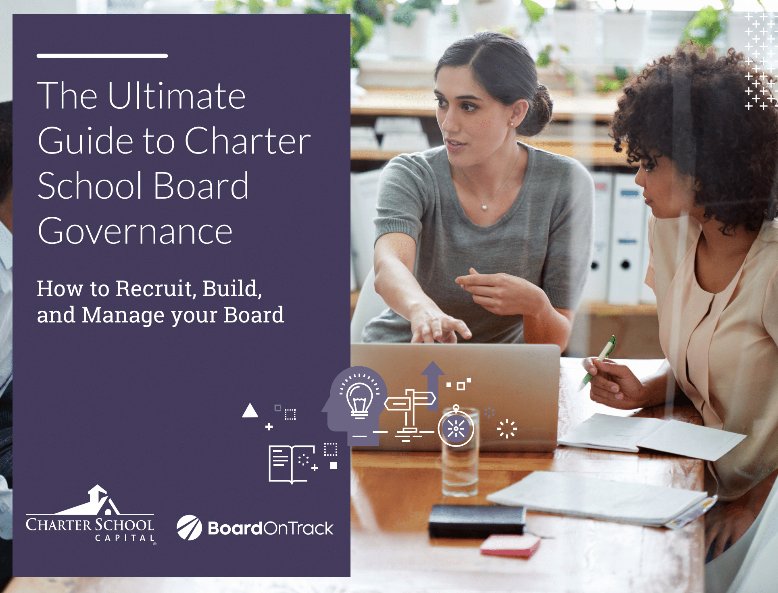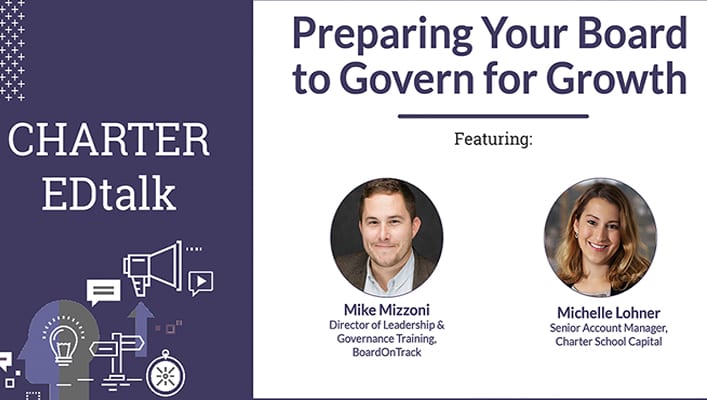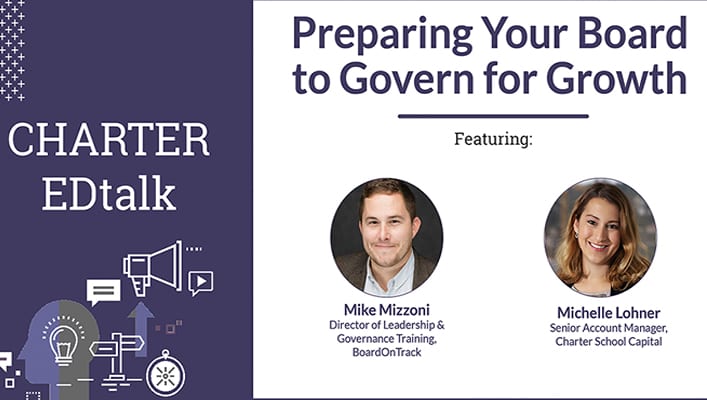Preparing Your Charter School Board to Govern For Growth
For this CHARTER EDtalk, Michelle Lohner, Sr. Account Manager at Charter School Capital, was joined by BoardOnTrack’s Director of Leadership & Governance Training, Mike Mizzoni to discuss how a charter school board can best govern for growth. Mike shares his expertise on why charter school boards should be governing for growth, what that means, planning your board so that evolves over time, setting board priorities, and choosing the right people on the board to effectively navigate every stage of your charter school’s growth.
To hear all of Mike’s tips and guidance, please watch the video below or read the complete transcript below.
VIDEO TRANSCRIPT:
Michelle Lohner: Hi, I’m Michelle Lohner with Charter School Capital, senior account manager, and have Mike Mizzoni here with us today, director of leadership and governance training from BoardOnTrack.
Mike Mizzoni: Happy to be here. Thanks so much.
Lohner: Thank you so much, Mike. So, really I know so many things we want to talk about, but we’ve been hearing a lot about having boards prepared for growth. Can you tell me a little bit? What does that mean?
Mizzoni: Yeah. We’re going around and promoting what we call this notion of governing for growth, and it’s a message that our company BoardOnTrack is really promoting, because we work with charter school boards around the country, and what we’ve found is that there are so many students who need the kind of programming that charter school offer, so we see schools with wait lists that are twice the size of their enrollment. We have schools that are actively looking to expand into other geographic locations, or to expand into new grades that they can serve, or new schools together.
What we’ve found is that as organizations go to evolve and to expand to the number of students that they can serve again either by growing into a new physical location or by expanding their grade levels that the governance that the board provides of the organization doesn’t always keep pace with the organization itself, and so what we’re doing is we’re really trying to promote this idea that boards need to be very methodical, intentional, about not just promoting the strategic direction of the organization, but also improving their own governance capabilities as well in some of the key areas of board governance.
Lohner: That’s actually really interesting that you mentioned that because like you said schools are growing. The board may or may not be keeping up with that, so how would you suggest that they do that? What does that look like?
Mizzoni: Yeah, so what we try and get boards to focus on are what we call the five Ps of good board governance, and so really these are the five key areas that good boards need to do well, and so these are the five areas that we say especially if you’re an organization that’s governing for growth that you need to keep your eye on. What we would call those are like I said the five Ps. They’re your priorities, your people, your process, your performance, and your progress. So quickly what we mean by that, when it comes to your priorities is making sure that the organization, the school leadership, and the board, are fully aligned on the direction that they’re headed, what it is that we’re trying to accomplish, what’s our vision of excellence look like for the organization.
With the people we’re talking about making sure that you’ve got the right people on your governance team, so the right board members with the right backgrounds, skills, demographics. Also, your officer positions and the leadership of the school, so your CEO, your school leader, and their designees, so those senior staff members. Those are all people who are involved in governing the organization.
Next thing is the process, so the way the board goes about doing its work, so complying with things like the Open Meeting Law, and your state’s authorizers requirements, things like your meeting, schedule. Little things like whether your meetings last for too long. We feel really strongly that good board meetings don’t need to last longer than two hours, and anything longer than that quickly leads to burn out of good board members.
So the way you do your work needs to change and evolve. When we talk about performance we’re talking holding each other accountable on your board to the performance metrics you’ve set for each other, but then also for the organization as a whole, and holding your CEO accountable. So one of the things we look for is how you evaluate and support your CEO at the end of the year.
And then, lastly when we talk about progress we’re talking about whether the board itself makes progress in these areas, so in its governance capabilities is the board improving its own capabilities, so things like watching CHARTER EDtalks, and getting professional development for your board is what we would look like there.
Lohner: That’s interesting. There’s like you said the five Ps that they need to focus on but how do they make sure that they focus on the right priorities, because there’s so many things that are coming their way that they need to give attention to as a board member.
Mizzoni: Yeah, that’s exactly right, and so when we talk about priorities, the first of those Ps, it really is making sure that everybody on the team knows exactly where they’re headed. One of the metaphors that I like to use is that this charter school board that we’re on is sort of an adventure that we’ve all elected to go on, and at some point we all got together and pointed at the mountaintop that we’re looking to head to, and with the nature of charter school governance, [inaudible 00:04:22] we tend to see three to five year charter renewal cycles.
The reality is if this group of individuals is going to get to where we’ve all agreed that we need to go we need to have clear priorities year by year that allow us to get there. And so, when it comes to governing for growth if we as a team, as a governing board, and our school leadership are not totally in sync as to where it is that we’re trying to head then we quickly find people pulling different directions. Leadership really starts at the top and if there’s misalignment as to where our priorities are then that trickles down throughout the organization.
Lohner: That makes sense. How can a board make sure, you talked a lot about the different priorities, but make sure that they have the right people to govern at each stage of this growth?
Mizzoni: Yeah, that’s one of the biggest challenges for sure when we travel around the country and talk to governing boards. One of the things that they have the most difficulty with is keeping a steady pipeline of really high-quality board members who are aligned with their mission, and willing to participate.
And so, that challenge becomes even more difficult as the organization is looking to govern for growth because what happens is the types of skillsets that an individual needs to bring to a board changes as the organization evolves. An example of it would be let’s say that we’ve elected as a team that we’re going to expand and replicate into another location. This might be the first time in a decade that we’ve ever needed to acquire a building.
In this case, we may never of had really a cause for needing somebody with real estate transaction experience, or school architecture, or facilities just in general. What we like people to think about is when they’re planning for the year, and they’re getting ready to set goals around recruitment is as you’re growing we really like boards to say what is it that this board needs to get done this year, and we’re going to recruit people specifically to fill those gaps.
We want to make sure that we always have a diverse set of skills so that we can do all of the things that a good charter school board needs to do, financial oversight, academic oversight, fundraising, all of these key areas. We want to make sure that we have people who meet each one of these needs so that combined as one governing team we have all of the skillsets combined.
Lohner: I like that. That’s actually really helpful in terms of best practices. You’ve had a lot of experience what would you say is the most common mistake that you see boards make?
Mizzoni: When it comes to boards that are governing for growth I’d say hands down the biggest mistake we see is people not prioritizing in governance. We know that a lot of organizations when they’re getting off the ground the governance portion of it is one of the last things that they go to. We know that most people are here because they want to educate students, they want to get results in the classroom, they’re really passionate about the mission.
We put all the focus on strategic planning and the direction and development of the organization, and we don’t put that same kind of spotlight or attention on us as the governing board, and so what we want is for people to not keep making that mistake. We want people to understand that the success of the organization is going to largely depend on the work of the governance team.
Unfortunately, the world that we live in is that not every charter school is successful for a long period of time, and unfortunately a lot of the reasons for why schools close can be traced back to some sort of either action or more importantly inaction on the part of the board, so putting an emphasis on a strong board governance is something that we want to see people do more, and not making that mistake again.
Lohner: Definitely. Mike, was there anything else? I really appreciate you coming on today and sharing some of your insights and best practices for governing for growth. Is there anything else that you wanted to share with everyone?
Mizzoni: No. My final conclusion I would say is that there are a lot of students out there who need what it is that your schools are offering, and so putting a spotlight and making sure that we’re keeping the board governance healthy throughout this sector is important to us.
Lohner: Thank you so much, Mike.
Mizzoni: Thank you.
Lohner: Thank you, everyone, for joining us.

For your school to reach its goals, meet its mission, and be set up for success, you need to build a well-structured, well-staffed, and well-trained Board of Directors. In this important webinar, our partners and industry experts on Board Governance, BoardOnTrack, will be sharing their expertise on the ins and outs of recruiting, building, and managing your governance team as you grow.
Watch and learn:
- Board basics: Who should be on your governance team and what should they do?
- How to build a strong board: Strategically recruiting for diversity and skills
- Tips to govern for growth: How to face challenges and changes at any stage
Download it now and get the tools to be more strategic about your school’s board governance practices!

